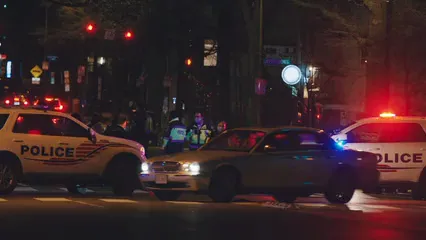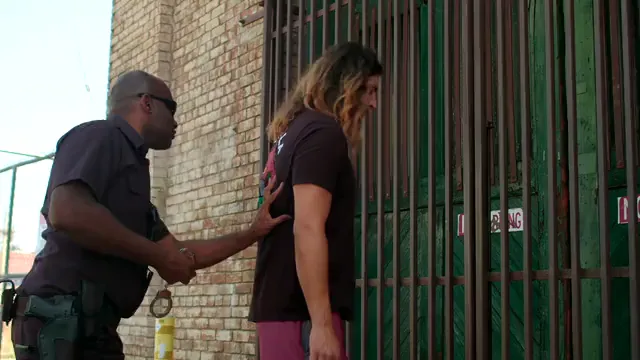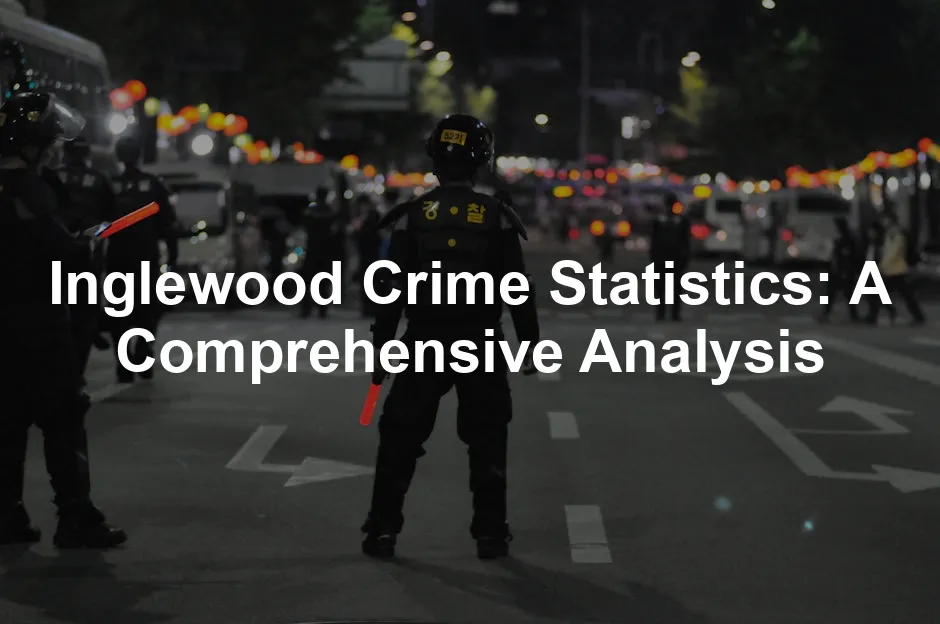Introduction
Welcome to Inglewood, California! Nestled within the Los Angeles County, Inglewood is a vibrant city known for its rich culture and diverse community. With its close proximity to the bustling metropolis of Los Angeles, it has become a popular spot for residents and visitors alike. However, like many urban areas, Inglewood faces its share of challenges, particularly concerning crime.
In this article, we aim to provide a thorough overview of crime statistics in Inglewood, diving into recent trends and comparisons with other regions. Understanding these statistics is crucial for potential residents, curious visitors, and policymakers. Knowledge is power, and being informed about local crime rates can help individuals make better decisions regarding safety and community involvement.
Let’s not beat around the bush—crime rates can cause concern. Whether you’re considering moving to the area, planning a visit, or involved in local governance, having a grasp of the crime situation is essential. So, buckle up as we analyze the numbers behind Inglewood’s crime statistics, shedding light on what they mean for the community.
Overview of Inglewood Crime Statistics
Description of Crime Rates
Inglewood has garnered attention due to its crime rates, which are notably higher than national and state averages. The overall crime rate stands at an alarming 36 per 1,000 residents. This means that if you’re living in this city, you have a 1 in 28 chance of becoming a victim of any crime. To put that into perspective, over 90% of communities in California have lower crime rates than Inglewood.
When we look closely at violent crimes, the numbers are indeed startling. The violent crime rate in Inglewood is approximately 6.65 per 1,000 residents. Comparatively, the national median for violent crime is 4 per 1,000. This disparity indicates that Inglewood residents face a significant risk of violent crime, with a 1 in 150 chance of being affected.
For those interested in understanding the psychology behind crime, consider reading The Psychology of Criminal Conduct by D.A. Andrews. This insightful read delves into the factors that drive individuals to commit crimes, offering a deeper understanding of the context behind statistics.
Historical Context
Examining crime trends over the past several years reveals an unsettling picture. Inglewood has seen a year-over-year increase of 15.5% in crime rates, raising eyebrows and prompting discussions about safety and community welfare. Previous years show fluctuating numbers, but the recent trend marks one of the most significant increases in recent history.
For context, violent crime rates have notably risen, with an increase of around 0.7%, while property crime has surged by approximately 19.6%. This increase raises questions about the underlying factors contributing to such a spike and what can be done to reverse this trend.
In conclusion, understanding the crime statistics in Inglewood is essential for evaluating the safety of this community. With a comprehensive overview of crime rates and historical trends, potential residents, visitors, and policymakers can engage in informed discussions and decisions about safety and community initiatives moving forward. As we move through this article, we’ll dive deeper into the specifics of violent and property crimes, providing a clearer picture of Inglewood’s crime landscape.

Breakdown of Violent Crime
Definition of Violent Crimes
Violent crimes represent some of the most serious offenses within our legal system. They include acts that threaten or inflict harm on individuals. Here’s a quick rundown of the main types:
- Murder: The unlawful killing of another person. Inglewood has reported 17 murders recently, a serious concern for community safety.
- Rape: This heinous act involves non-consensual sexual intercourse. Inglewood recorded 54 rapes, highlighting a critical issue in community safety and support.
- Robbery: This crime involves taking property from someone through force or intimidation. With 294 robbery incidents in Inglewood, it raises alarms about personal safety.
- Assault: This includes any act that causes physical harm or threatens to do so. Inglewood’s assault numbers stand at 324, a significant figure that reflects community tensions.
Statistics on Violent Crimes
Inglewood’s violent crime statistics present a stark picture of safety in the community. The violent crime rate is approximately 6.65 per 1,000 residents. When you look closer, the chance of becoming a victim of violent crime here is about 1 in 150 individuals. Here’s a detailed breakdown of violent crimes:
- Murder: 17 incidents
- Rape: 54 incidents
- Robbery: 294 incidents
- Assault: 324 incidents
These numbers reflect not just statistics, but real lives affected. Each incident represents a personal story, often marked by trauma and community impact. If you’re interested in understanding the implications of trauma on victims, I highly recommend The Body Keeps the Score. It’s a profound exploration of trauma’s effects and healing processes.
Comparison with National Averages
When we stack Inglewood’s statistics against national averages, the results are rather alarming. The national median for violent crime is about 4 per 1,000 residents. Inglewood’s rate of 6.65 per 1,000 is noticeably higher, making it clear that residents face more risks than many others across the country.
To put it into perspective, the chance of being a victim of violent crime nationally is lower than in Inglewood. The national average indicates that 1 in 200 people might experience such a crime, while Inglewood’s rate of 1 in 150 shows a significant increase in risk. These statistics reflect ongoing community challenges and the pressing need for effective safety measures.
Inglewood’s rising violent crime rates call for urgent attention from local authorities and community members. Engaging in conversations about safety, supporting local initiatives, and fostering community relationships are critical steps toward a safer Inglewood. Understanding these figures is a crucial first step for residents and visitors alike, as it underscores the importance of community involvement in addressing crime.

Community Perceptions of Crime and Safety
Understanding how residents perceive crime and safety in Inglewood provides valuable context. After all, statistics tell one side of the story, but community sentiment adds depth. Recent surveys shed light on how locals feel about their environment.
Surveys and Polls
According to recent polls, the sentiment toward safety in Inglewood varies widely. Out of 70 respondents, 57% reported feeling “pretty safe.” They acknowledged some safety concerns but maintained a general sense of security. A further 27% described themselves as “somewhat safe,” indicating they had noticeable concerns. Only 13% claimed to feel “very safe,” and a mere 3% felt outright unsafe. These findings paint a picture of a community that, while facing challenges, still finds reasons to feel secure.
Interestingly, when asked about the effectiveness of law enforcement, opinions shifted. Many residents appreciate police visibility, with 35% stating that officers are “very visible and responsive.” However, 31% felt the police were visible but slow to respond when needed. A significant portion, 21%, reported that officers weren’t often around but responded quickly when called. This mixed sentiment highlights a community grappling with trust in law enforcement, a crucial factor in fostering safety.
Public Sentiment Towards Law Enforcement
Public sentiment toward law enforcement in Inglewood is complex. While many residents acknowledge the police presence, concerns about response times linger. The feeling of being safe is often tied to the perception of law enforcement’s effectiveness.
Inglewood police have made efforts to engage with the community, yet challenges remain. Some residents express frustration over the slow response to urgent situations. This perception can lead to a lack of trust and a feeling of vulnerability. A proactive approach to community policing could bridge the gap.
Overall, while many residents feel a degree of safety, there is a clear desire for improved police responsiveness. Community engagement initiatives could enhance feelings of security and build trust. As the city continues to address crime, understanding these perceptions becomes essential for creating a safer environment.

Factors Contributing to Crime in Inglewood
Various factors contribute to the crime rates in Inglewood. These elements often intertwine, creating a complex web that affects community safety.
Economic Factors
Economic challenges play a significant role in crime rates. High poverty levels, unemployment, and soaring housing costs contribute to a climate where crime can flourish. Inglewood’s rental prices are notably high, averaging around $1,414 per month, which exceeds the national average of $949. This financial strain can lead to desperation, pushing some individuals toward criminal activities as a means of survival.
Unemployment rates in Inglewood further exacerbate this issue. Limited job opportunities can create an environment where crime becomes an attractive option. As residents struggle to make ends meet, the temptation to engage in illegal activities increases. Addressing these economic disparities is crucial for long-term crime reduction.
For those looking to enhance personal safety, a Personal Safety Alarm Keychain can be a game-changer. This small yet powerful device can help alert others during emergencies, providing an added layer of security while out and about.
Social Dynamics
Social dynamics also play a pivotal role in shaping crime rates. Inglewood’s population density is significantly higher than the national average, which can create tensions. With more people living in close quarters, the potential for conflict increases.
Gang activity remains another critical factor influencing crime in Inglewood. The presence of gangs often leads to violence and property crimes, creating a culture of fear. This atmosphere can discourage residents from reporting crimes, further complicating the situation.
Addressing these social dynamics requires a multifaceted approach. Community programs aimed at fostering unity and providing resources can help mitigate these issues. By tackling the root causes of crime, Inglewood can move toward a safer, more secure environment for all its residents.

Popular Neighborhoods and Safety Ratings
Overview of Neighborhoods
Inglewood boasts a variety of neighborhoods, each with its unique charm and character. For instance, Hollywood Park is often recognized for its proximity to the SoFi Stadium and its lively atmosphere. This neighborhood attracts sports fans and concert-goers alike. Downtown Inglewood is another hotspot, featuring a blend of retail, dining, and cultural attractions. It’s a bustling area that has seen significant revitalization in recent years, making it a preferred choice for many newcomers.
Century Heights offers a quieter suburban feel. Residents appreciate its family-friendly vibe and access to parks. Meanwhile, Morningside Park is known for its spacious homes and green spaces, making it ideal for those who seek tranquility amidst urban life.
Other notable neighborhoods include Inglewood Knolls, characterized by its charming architecture, and Fairview Heights, which features a mix of residential and commercial properties. Centinela Heights is a favorite among those who enjoy a bit more space, while North Inglewood offers a diverse community atmosphere. Each neighborhood has its unique flavor, aspects that help shape the overall community experience.

Safety Ratings by Neighborhood
When it comes to safety, the neighborhoods in Inglewood vary significantly in their crime rates. Hollywood Park generally enjoys a better safety rating compared to other areas. Residents feel relatively secure, thanks to community policing efforts and active neighborhood watch programs.
In contrast, Downtown Inglewood presents more challenges, often grappling with higher crime rates. While the area is bustling and vibrant, its safety ratings can be a concern, particularly during late hours. Residents and visitors are encouraged to remain vigilant, especially when exploring the nightlife.
Century Heights and Morningside Park rank higher in safety ratings. Residents here often report feeling comfortable walking alone, even at night. The community-oriented atmosphere contributes to these neighborhoods’ positive perceptions.
However, North Inglewood and Fairview Heights show a mix of safety ratings. While some parts are relatively safe, others experience higher instances of property crime. It’s wise for potential residents to research specific streets and blocks before making a decision.
Ultimately, understanding the safety ratings in these neighborhoods can help residents and visitors navigate Inglewood more confidently. Awareness and engagement in community efforts can also play a crucial role in improving overall safety.

Conclusion
Inglewood’s crime statistics paint a complex picture, revealing both challenges and progress. The analysis shows that while the overall crime rate is higher than national averages, certain neighborhoods shine brighter than others in terms of safety. Understanding these dynamics is essential for residents and visitors alike.
It’s crucial to stay informed about local crime rates. Knowledge empowers individuals to make educated decisions regarding their safety and community involvement. Whether you’re a long-time resident or a newcomer, being aware of crime statistics can enhance your understanding of the area.
Community engagement is vital in improving safety. Residents are encouraged to participate in neighborhood watch programs, attend community meetings, and foster relationships with local law enforcement. By working together, Inglewood can cultivate a safer environment for everyone.

Inglewood has a vibrant community spirit that can make a difference. By actively participating in local initiatives, residents can help shape a brighter future for their neighborhoods. Remember, safety isn’t just about statistics—it’s about community collaboration and engagement. Stay informed, get involved, and contribute to a safer Inglewood for all!
FAQs
What is the overall crime rate in Inglewood?
Inglewood has a concerning overall crime rate of 36 per 1,000 residents. This makes it one of the more hazardous places in California. To add a pinch of perspective, the chance of becoming a victim of any crime in Inglewood is about 1 in 28. That’s not exactly the odds you’d want to be dealt while playing poker, right?
How does Inglewood compare to other cities in California?
When stacked against nearby cities like Hawthorne and Culver City, Inglewood’s crime rates stand out. For instance, Hawthorne has a crime rate of about 34 per 1,000 residents, while Culver City is around 25 per 1,000. So, if you’re looking for a safer bet, you might want to consider those options. Inglewood’s rate is higher, meaning residents face more risks compared to their neighbors. A friendly reminder: always check the local stats before planning your next move!
What should residents do to stay safe in Inglewood?
Safety in Inglewood isn’t just about luck; it requires proactive steps. Here are some practical tips for residents: 1. Stay Alert: Keep your head on a swivel. Awareness of your surroundings can make a big difference. 2. Report Suspicious Activity: If you see something odd, say something! Alert local authorities. 3. Use Well-Lit Areas: Stick to well-lit streets, especially at night. Remember, dark alleys are not your friends. 4. Join Community Programs: Engage with neighborhood watch programs. It’s a great way to meet people and stay safe. 5. Secure Your Home: Ensure that doors and windows are locked. Consider investing in a security system for peace of mind. These actions can help foster a safer environment for everyone in the community.
Are there local resources for crime prevention?
Absolutely! Inglewood has several resources focusing on crime prevention. The Inglewood Police Department often hosts community meetings, providing safety tips and updates on local crime trends. They also offer a “Neighborhood Watch” program, which encourages residents to collaborate for safety. Additionally, organizations like the Inglewood Community Coalition actively promote crime reduction strategies and community engagement. They work tirelessly to create a supportive environment, making it easier for residents to connect and share safety tips. Inglewood also boasts several local non-profits that focus on youth outreach and education, addressing some of the root causes of crime. Engaging with these resources can help residents feel more connected and informed about their community’s safety. By taking advantage of these resources, residents can play an essential role in crime prevention and community safety.
Please let us know what you think about our content by leaving a comment down below!
Thank you for reading till here 🙂
For a detailed examination of crime trends, you can check the fremont crime statistics which provide insights into safety comparisons.
If you’re intrigued by the intersection of crime and culture, you might also enjoy The Devil in the White City. This gripping narrative weaves together the history of a world’s fair and a serial killer, showing how crime can shape a city’s identity.
All images from Pexels




